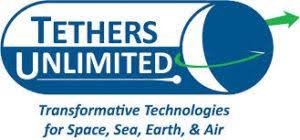I have blogged before about all the debris orbiting the Earth left over from space launches. It is estimated that there are more than one hundred million pieces of debris that are less than 1 centimeter in size. They are too small to track with radar but are big enough to cause serious damage to a space craft because they are traveling so fast. The United States Strategic Command tracks about eighteen thousand pieces of debris that are bigger than four inches. If fact, if the debris keeps piling up, it may become impossible to safely launch a payload into Earth orbit or beyond. A variety of systems have been proposed for removing debris from orbit.
Tethers Unlimited (TU) is located in Bothell, WA. In collaboration with TriSept Corp., Millennium Space Systems and Rocket Lab, they are going to test a new system to remove satellites from orbit which are no longer operational. The system is called Terminator Tape. It involves incorporating a module into a satellite which can unwind a strip of electrically conductive tape when the satellite is no longer in use.
TU explained the system in an online post that said, “This tape will significantly increase the aerodynamic cross-section of the satellite, enhancing the drag it experiences due to neutral particles. In addition, the motion of this tape across the Earth’s magnetic field will induce a voltage along the tape. This voltage will drive a current to flow up the tape, with electrons collected from the conducting ionospheric plasma at the top of the tape and ions collected at the bottom. This current will induce a ‘passive electrodynamic’ drag force on the tape.”
It is believed that the increased drag on the satellite from the tape will significantly cut down the time that it takes to drag the satellite down to burn up in the atmosphere. TU has already sent its Terminator Tape module into Earth orbit in several small satellites. However, the Dragracer satellite mission due for launch next year should be the best test for the Tape. There will be a control experiment included in the test.
Millennium Space Systems is a Boeing subsidiary located in California. It will construct and operate the fifty-five pound Raptor-class satellite for the Tape test. TriSept is a company located in Virginia. They will handle launch integration and mission management services for the test. And, finally, Rocket Lab will include Dragracer in a ride share on its Electron rocket that will be launched from New Zealand in early 2020.
When the satellite reaches orbit, it will divide into two payloads. One of them will initiate the deployment of the Tape and the other will experience just atmospheric drag without the Tape. Mission managers estimate that it will take two to four weeks for the payload with the Tape deployed to deorbit while the other payload will take from eight to twelve months to descend from orbit.
Mike Scardera is vice president of advanced concepts for Millennium Space Systems. He said, “The Dragracer mission is all about providing an affordable, effective and scalable solution to the orbital debris challenge facing the LEO small-satellite market and the global space. It is the first in a series of critical project missions we expect to launch with TriSept.”
The president and CEO of TriSept, Rob Spicer, said that the Dragracer test will demonstrate a new creative solution to the problem of dead small satellites that are piling up in orbit. Hopefully, some of the small satellites that will be launched in the future will include the Tape deorbiting system developed by Tethers Unlimited.
